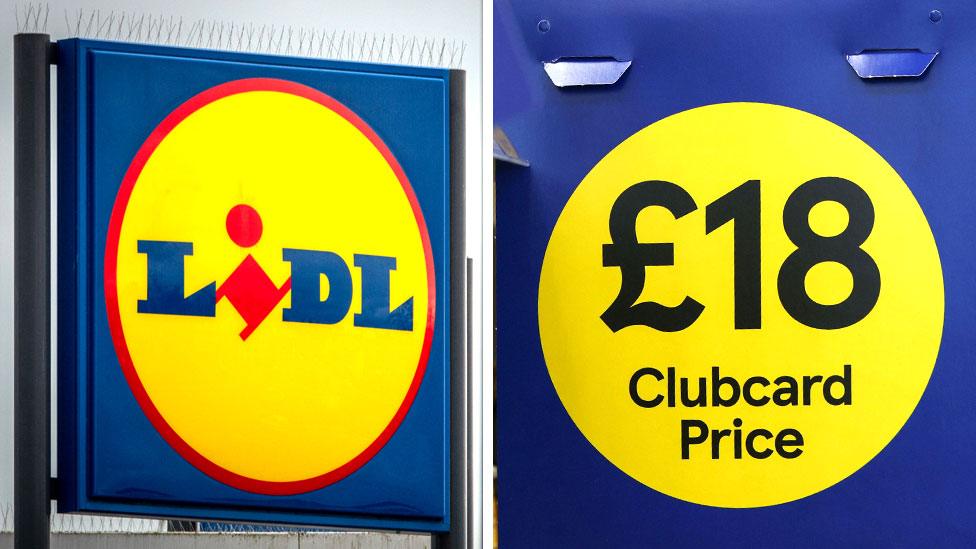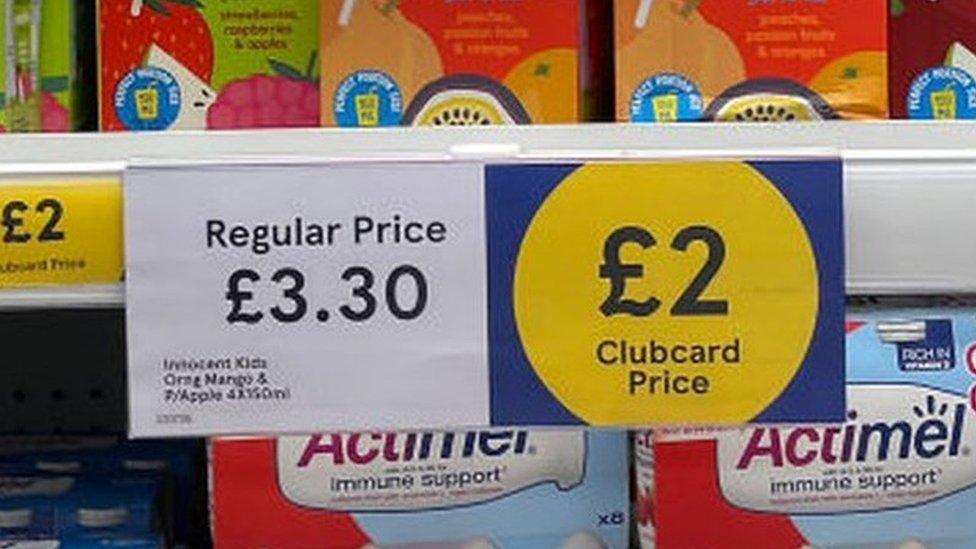Tesco to change Clubcard logo after losing Lidl legal battle
- Published

Tesco has been told to stop using its Clubcard Prices logo after losing a long legal battle with rival Lidl.
The German discounter had argued the Clubcard logo of a yellow circle on a blue square infringed its copyright, and took "unfair advantage" of its "reputation for great value".
Last year the High Court found in favour of Lidl and on Tuesday the Court of Appeal agreed.
Lidl said it was "delighted", while Tesco said it was "disappointed".
Customers can expect to see a change to its Clubcard Prices logo in the coming weeks.
The legal saga between the two supermarkets began in 2020 when Lidl launched the lawsuit against Tesco after it started using the distinctive logo for its Clubcard scheme.
Lidl argued Tesco had deliberately copied its trademark to deceive customers into thinking its prices were comparable.
In 2023 the High Court ruled that the Clubcard logo did copy Lidl's logo, but Tesco appealed against that decision.
In a statement issued after Tuesday's ruling by the Court of Appeal, Lidl said that Tesco had "prolonged the dispute... deceiving customers for another year".
"We are delighted to see that the Court of Appeal has now agreed with the High Court that Tesco's use of its Clubcard logo is unlawful.
"We expect Tesco now to respect the Court's decision and change its Clubcard logo to one that is not designed to look like ours," it said.
Meanwhile, Tesco moved to reassure its customers and said it was "consistently the cheapest full-line grocer".
"We are disappointed with the judgement relating to the colour and shape of the Clubcard Prices logo but would like to reassure customers that it will in no way impact our Clubcard Prices programme.
"Clubcard Prices, irrespective of its logo, will continue to play a central role in rewarding our Clubcard members with thousands of deals every week," it said in a statement to the BBC.
Consumer expert Kate Hardcastle said it was no surprise Lidl fought against the UK's largest supermarket chain in what she described as an "ultra hotly-contested market".
But she told the BBC that the use of yellow in marketing was a "very attractive colour commonly used across the industry".
"Should they [Tesco] have avoided it? For Lidl which has so much protection around it, they're watching with eagle eyes, they're going to fight for their brand, as Tesco would have done if it were reversed," she added.
Ms Hardcastle said that while it was understandable Tesco was disappointed by the court's decision, it represented a marketing opportunity for the supermarket to design a "really clever" new logo, though pointed out the costs would "not be cheap".
"It's time for Tesco to be smart," she said. "By keeping it simple, they can create and protect something in the same way that Lidl have done."
However, supermarket branding expert Campbell Rigg told the BBC the whole affair could have been avoided had Tesco's marketing team done so-called "benchmarking" research before designing the logo.
Benchmarking is a process where other competitors are looked at to see how their brands are positioned within the market.
"Before you start the conceptual work you must do the benchmark, otherwise you have no knowledge, one arm tied behind your back and one of your legs cut off," said Mr Rigg, who worked as a brand consultant for Tesco for 15 years.
"It could have been avoided," he added. "Though I expect Tesco will be able to brush off any costs."
- Published19 April 2023

- Published16 April 2023

- Published2 February 2022
